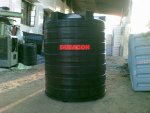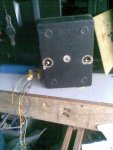Hi friends,
I am hobbits in electronics..
And I am very crazy to build this project....
I just want your help guys to complete this ?
I want to make a circuit using PIC MICRO CONTROLLER which fills my tank automatically..
As my tank becomes full it should turn off the motor pump
-------------------------------------------------------
As my tank becomes low it should then turn on the motor
---------------------------------------------------------
But before filling the tank it should first check the existing of water by another sensor...
As this sensor becomes wet then we can understand that water is getting inside the tank..
and then it can continue to fill the tank....but the time will be only 5 minutes .It will have to check the existing of water between 5 minutes.If the water doesn't comes in 5 minutes then it will turn off the motor pump and restart after 1 hour and the process repeats....
----------------------------------------------------------------------------------------------------
SO in short we require three sensor ie : LOW , FULL AND WATER Sensors and a picaxe to control it as required...
Note : It is necessary that the sensors are corrosion free..
So we require total following circuits to accomplish this project :
1) Three corrosion free sensors to sense the the level of water.
2) A PICAXE Micro-Controller to control the motor pump according to the sensed water level.
3) A Program code which will need to program this PICAXE Micro-controller..
------------------------------------------------------------------------------>>>>>>>>>>>>>>>>>>>
Well , I have got a circuit diagram which is little bit related to this project :
The link is :
http://www.picaxeforum.co.uk/showthread.php?12266-08M-Christmas-tree-watering-controller&highlight=christmas
=========================================================================
I hope we will have to do some modifications in Christmas-tree-watering-controller circuit and code and that's all !!
waiting for reply :
Mike
I am hobbits in electronics..
And I am very crazy to build this project....
I just want your help guys to complete this ?
I want to make a circuit using PIC MICRO CONTROLLER which fills my tank automatically..
As my tank becomes full it should turn off the motor pump
-------------------------------------------------------
As my tank becomes low it should then turn on the motor
---------------------------------------------------------
But before filling the tank it should first check the existing of water by another sensor...
As this sensor becomes wet then we can understand that water is getting inside the tank..
and then it can continue to fill the tank....but the time will be only 5 minutes .It will have to check the existing of water between 5 minutes.If the water doesn't comes in 5 minutes then it will turn off the motor pump and restart after 1 hour and the process repeats....
----------------------------------------------------------------------------------------------------
SO in short we require three sensor ie : LOW , FULL AND WATER Sensors and a picaxe to control it as required...
Note : It is necessary that the sensors are corrosion free..
So we require total following circuits to accomplish this project :
1) Three corrosion free sensors to sense the the level of water.
2) A PICAXE Micro-Controller to control the motor pump according to the sensed water level.
3) A Program code which will need to program this PICAXE Micro-controller..
------------------------------------------------------------------------------>>>>>>>>>>>>>>>>>>>
Well , I have got a circuit diagram which is little bit related to this project :
The link is :
http://www.picaxeforum.co.uk/showthread.php?12266-08M-Christmas-tree-watering-controller&highlight=christmas
=========================================================================
I hope we will have to do some modifications in Christmas-tree-watering-controller circuit and code and that's all !!
waiting for reply :
Mike
Last edited:





